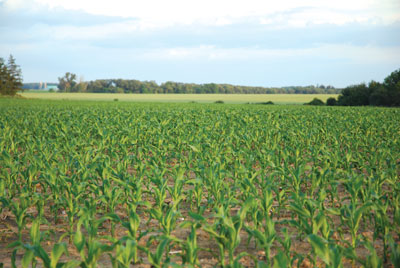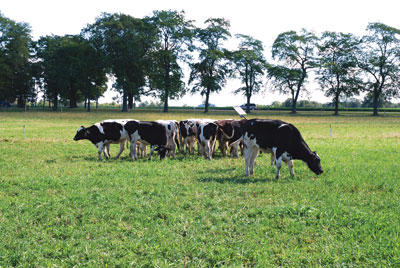
News
Do ethanol plants affect land use?
Research from the University of Illinois at Chicago has revealed that a modern ethanol plant has negligible effects on land use. The findings contradict other studies that claim corn-based ethanol contributes more to greenhouse gas emissions than previously thought. The land-use change issue is yet another point of contention in the ongoing debate concerning the use of corn as a feedstock in the expanding North American biofuel market.
April 30, 2010 By Blair Andrews
Research from the University of Illinois at Chicago has revealed that a
modern ethanol plant has negligible effects on land use. The findings
contradict other studies that claim corn-based ethanol contributes more
to greenhouse gas emissions than previously thought. The land-use
change issue is yet another point of contention in the ongoing debate
concerning the use of corn as a feedstock in the expanding North
American biofuel market.
 |
|
| Research from the US Midwest indicates that corn acreage actually decreased around both a newly constructed ethanol plant and one that expanded in 2008.(Photos by Ralph Pearce) |
|
 |
|
| Further research on the impact of corn and ethanol production should also include the livestock sector. |
The same land-use issue is fuelling similar discussions in Western
Canada concerning the use of small grains for ethanol production.
Two theories against corn-based biofuel allege that increased ethanol
production results in native land being converted into crop production
and an increase in the number of corn acres planted versus other crops.
Previous studies examined two types of land-use changes: direct and
indirect. Direct land use change refers to the conversion of acres in
the direct supply chain of an ethanol plant. Indirect land use change
takes market forces into account, which act to induce land-use change
on domestic but mostly foreign land that is not part of the direct
supply chain. For example, one proposition of indirect land-use change
is that increased ethanol production in the United States leads to
increased planting of corn, which reduces available areas for soybean
production. This reduces soy exports from the US prompting other
countries, such as Brazil to adjust their agricultural land use and
ultimately convert native land to meet the soybean shortfall created by
US biofuels production.
Led by Dr. Steffen Mueller, the Energy Resources Center at the
University of Illinois at Chicago has examined the land-use impacts of
two ethanol plants in Rochelle and Annawan, Illinois. “I’m looking at
mostly direct land use, and the premise of my argument is if we don’t
see any direct land-use change after an ethanol plant goes into an
area, and there are increased yields, there shouldn’t be any indirect
effect,” says Mueller.
Using satellite images and farmer surveys, the research monitored each
acre of farmland within a 20- to 40-mile (32- to 64-kilometre) radius
of the plants before they opened and after. In addition to land-use
change, the study also examined the land carbon balance for corn
produced to supply the plants. “We found that there was, before and
after the plants went in, at a maximum, a couple of hundred acres of
changes of non-agricultural land to agricultural land that took place
in the startup of the ethanol plant,” explains Mueller. “We concluded
that an ethanol plant going into a particular area, at least in the
central Midwest, will likely not prompt large-scale conversion of
non-agricultural land in the area.”
Mueller’s research, commissioned by the Illinois Corn Growers
Association, started with the Illinois River Energy Center that began
operating in Rochelle in December 2006. The study has been updated to
include the plant’s expansion in November 2008, as well as the Patriot
Renewable Fuels plant in Annawan that started in September 2008. The
analysis performed for the corn supply areas showed that 534 acres of
forest and 105 acres of grassland were converted around the Rochelle
plant while 609 acres of forest and 6 acres of grassland were converted
to corn near the Annawan plant.
The study also notes that the draw of the ethanol plants was relatively
small compared to the amount of corn produced in the areas, and
increases in corn yield in the regions were sufficient enough to meet
the ethanol plants’ demand.
Despite the start-up of the one plant and the expansion of the other in
the fall of 2008, Mueller says the corn acreage decreased, providing
further evidence that the ethanol plants have a weak influence on corn
rotations.
In-depth numbers do not jibe with speculation
As for the assertion that ethanol plants indirectly affect land use
elsewhere, the study analyzed Illinois’ corn production, export and
uses. It showed that during the past 35 years, corn production almost
doubled from 1.2 billion to 2.2 billion bushels. Moreover, corn
carryout has also been on the rise. The study notes that feed corn has
been decreasing, which may be indicative of decreasing livestock but
also increased use of dried distillers’ grains with solubles (DDGS) as
feedstock. Meanwhile, the data shows that corn production increases on
relatively constant corn acres were sufficient to support both
increasing exports as well as corn for ethanol use.
Another notable aspect of the study is the method by which it examined
the land-use issue. Mueller says that his research differs from the
other studies because it takes a bottom-up approach, meaning it uses
relevant farming data, including farmer surveys and sophisticated
satellite imagery. “We’re using actual land-use change analysis on the
ground; it’s a big difference from using a computer model,” says
Mueller.
The implications of these assessments are significant to the future
direction of ethanol policies, particularly in the US. The concept is
to ensure that certain energy sources that are promoted as greener
alternatives to gas and oil are not actually worse options than the
fossils fuels.
One such case is playing out in California. Ethanol supporters have
been crying foul over the way the Air Resources Board in the state is
regulating its low carbon fuel standard. By using the indirect land-use
change figure in its calculations, the carbon footprint of corn ethanol
is increased. Ethanol proponents, pointing to Mueller’s research to
support their case, argue that current and future technological
advancements in agriculture need to be accurately accounted in the
assessments of renewable fuels.
Dr. Claudia Wagner-Riddle, professor in the School of Environmental
Sciences at the University of Guelph, is also of the opinion that the
agricultural data in these models should be improved. In several cases,
she notes that the models use emission factors that are not
representative of local soil and crop management practices. “It is
important to consider how corn is grown. What are the inputs in terms
of nitrogen fertilizer, and the typical yields for a region? Are best
management practices used? Often the numbers used are not the best for
a given location.”
She adds that having better data will be important as Canada seeks to
provide life cycle assessments on growing biomass for fuel or energy
under Ontario or Canadian conditions.
In another reaction to the Illinois research, Dr. Al Mussell, senior
research associate at the George Morris Centre, would like to see a
longer-range analysis on the impact of ethanol production. Mussell has
co-authored several studies on the impact of ethanol on Canada’s
livestock sector. He says that the main anticipated result from the
construction of an ethanol plant is that the local corn basis will
strengthen. “The result of that is, over time, it provides an incentive
to move acreage into corn from other uses. While the Illinois study
results show the corn acreage hasn’t changed much, you won’t get
dramatic shifts when you have acreage bound by crop rotations, and the
latent potential of shifting acreage also strengthens the basis for
soybeans.”
Mussell adds that acreage shifts will be gradual, and looking for them
in such a short time frame with so many other potential factors,
including wet weather delaying corn planting, may not be a sufficient
assessment.
More than just cropping issues
When discussing changes in pasture acreage, Mussell says it is
important to consider how the livestock sector operates. With so much
time and money invested in the business, he says the producers are not
likely to abandon it quickly. “When you get talking about pasture, for
folks that are in the cattle business, it’s a very long lag time,
driven by gestation and biology,” explains Mussell. “If you have a herd
of cows that you’re breeding and putting your imprint on, you’re
loathing to get out of that business. I could show you any number of
places in Ontario where folks, even if they understood their land
values, and understood there’s no way they can afford to have cows
running on it, are loathe to get out of it because this is their
career, their life’s work, and they’ll absorb a fair amount of
financial hardship and stick with it.”
From the perspective of a farmer, and an ethanol producer, Tom Cox says
the impact of an ethanol plant is creating more enthusiasm to grow
corn. Cox is chair of the Integrated Grain Processors Co-operative
(IGPC) in Aylmer, Ontario. The IGPC ethanol plant started operating in
the fall of 2008 and Cox says that some farmers may be more
enthusiastic, but he is not sure how that optimism translates into
tangible cropping plans, noting that the wet, cool spring of 2009 made
it difficult to plant corn. “The most compelling argument is the fact
that since about 2002, the output of ethanol from North America,
derived almost entirely from grain, has increased by more than 400
percent,” says Cox, commenting on the land-use issue. “Meanwhile, corn
exports from the US have remained very much within normal annual
variation while soybean exports continue to increase and are about 20
percent higher this year from 2002 when the current rapid expansion of
the ethanol industry began.”
Furthermore, Cox says that because the ethanol industry has experienced
rapid expansion without sacrificing domestic or export markets, a less
frantic expansion should be manageable in the coming years. “If we are
to believe, according to those advancing the land-use issue, that corn
usage for ethanol in North America is causing land to be diverted from
soybean production here, then it would seem to follow that we would see
declining, not growing, North American soybean exports,” says Cox.
As for the future of the land-use debate and the role of life cycle
assessments are concerned, ethanol proponents have received some
positive news. Their requests for better information about calculating
land-use impact did not fall on deaf ears. The California Air Resources
Board has agreed to convene an expert working group to help refine and
improve its land-use analysis. The group has been directed to evaluate
key factors that might impact the land use values for biofuels,
including agricultural yield improvements, changes in farming practices
and biofuel co-products such as DDGS. The group is expected to return
to the board with its recommendations by January 2011.